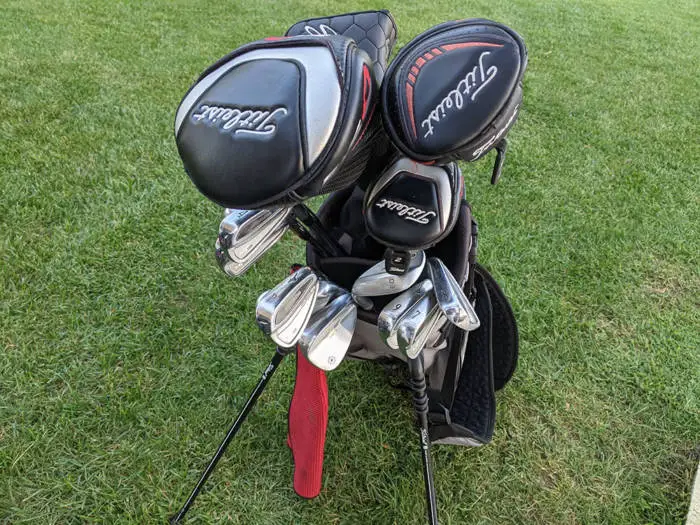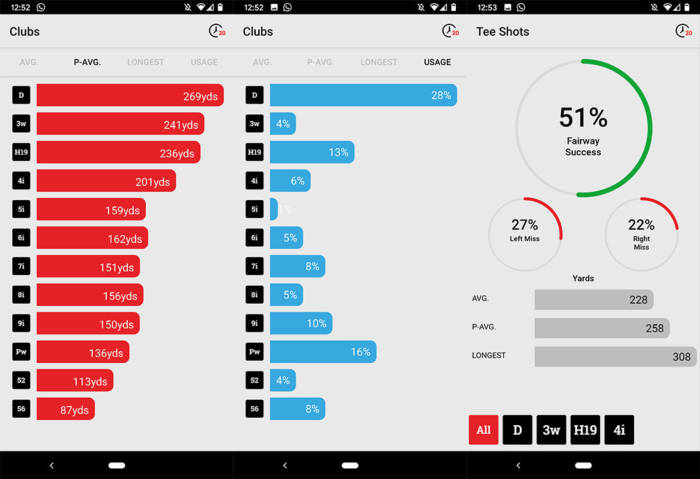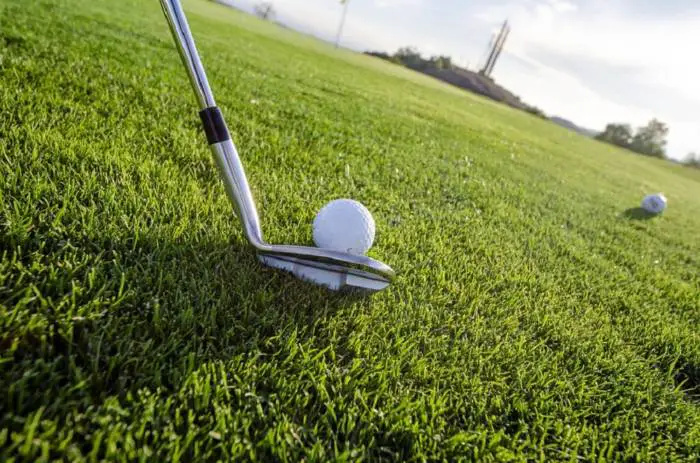When to Use What Golf Club
When playing golf, some courses call for a wide range of clubs to play to the best of your ability. You can carry up to 14 golf clubs on the course, but the key to scoring well is using the right club in the right circumstances.

In this article we’ll run through when it’s best to use each of the different types of golf clubs.
Average golf club distances
The most obvious factor that comes into deciding which golf club to use is the distance of the shot required.
Each golf club has a different loft which is designed to make the golf ball travel a certain distance. Therefore the distance the ball needs to travel should be the first factor that you consider when choosing your club.
But it’s not an easy task if you don’t know the distances you hit your clubs.

A good way to figure this out is by using a shot tracking device or app that integrates with a golf GPS. This will give you instant feedback on the distances you hit each club and allow you to make better on course decisions.
I’d recommend using something like the Shot Scope or Arccos Smart Caddie on the course for a few rounds which will give you a better indication of your club distances on course. You can read our full reviews of both here:
If you don’t have access to a GPS or the time to go through this exercise, then you can use the average golf club distances below as a guide and determine over time how far you hit each club in relation to the average.
| Club | Average Men’s Distance | Average Women’s Distance |
| Driver | 230 yards | 200 yards |
| 3 Wood | 210 yards | 180 yards |
| 5 Wood | 190 yards | 170 yards |
| 3 Iron | 180 yards | 160 yards |
| 4 Iron | 170 yards | 150 yards |
| 5 Iron | 160 yards | 140 yards |
| 6 Iron | 150 yards | 130 yards |
| 7 Iron | 140 yards | 120 yards |
| 8 Iron | 130 yards | 110 yards |
| 9 Iron | 120 yards | 100 yards |
| PW | 110 yards | 90 yards |
| SW | 90 yards | 80 yards |
| LB | 65 yards | 60 yards |
But it’s not just distance you hit the ball that plays a factor in determining when to hit each club. Other on-course elements such as height, wind, pin position and the lie of the ball can all affect which club is ultimately the best for the job.
Below we’ll run through each club and help you determine when is best to use each of them.
The Driver

This one is probably the easiest on the list, with the driver mainly being used for one thing only – distance.
Golf is a much easier game the further you can hit it. And on holes a bit of distance is required from the tee, you need to give yourself as much of a headstart as possible.
Your driver, although the easiest to choose, is one of the most important to use in your game. It’s the foundation of a good golf game and it’s no coincidence that the highest ranked PGA tour players are also the ones that hit it the furthest.
3-Wood & 5-Wood
Whilst the driver is your go-to club for distance off the tee, it also gives you the largest amount for error. A slight mis-hit or having the clubface a couple of degrees open or closed at impact can result in a shot that goes way off line.
On holes where a little more control is required, this is where your woods come into play. A 3-wood or 5-wood offers more control when teeing off, which can increase your chances of hitting the fairway, giving you an easier, safer second shot.
You won’t hit it as far, but on holes where accuracy is more important it’s worth considering dropping down to a wood for that extra assurance.
Long Irons (3-5) & Hybrids
If you drop down to a wood on par 4’s where more accuracy is required, then teeing off with your long irons or hybrids is a good strategic play on the tightest of holes.
There may not be many instances in a round of golf, but on holes where a loose shot can result in water or a lost ball, hitting a long iron or hybrid can reduce your margin for error further and keep your ball in play.
Aside from off the tee, typically when using a long iron, you’re looking for a longer shot, aiming to make up ground and to get as much distance as possible. Generally this will be the second shots on par 5s or approach shots on long par 4s.
Be careful though, long irons can be fairly difficult to hit – particularly from the rough. If you ball isn’t sitting pretty it’s worth considering dropping to a higher iron to ensure you get out of the bad lie. This is also where hybrids come in.
In modern golf, lots of trust is being placed in hybrid clubs. The clubs are much more forgiving than long irons and the shape of the club head means they cut through the rough a lot easier than long irons. They are also easier to hit from the fairway and promote a higher ball flight, adding more control and distance to your swing.
Mid & Short Irons (6, 7, 8 and 9-Irons)
In golf, the higher the number of the club, the more height and less distance on your shot. A 6-iron will be used for middle-of-the-park shots that need a balance between height and distance. And if you really struggle hitting longer irons, the 6-iron can also be replaced with a 5-hybrid, like the 5-iron.
As you get closer to the hole, the higher the number of iron you’re likely to be needing to use on your approach shot to the green. However, there are other instances where you may need to use a higher iron too.
Mid-short irons are great at cutting through the rough. If you have an exceptionally bad lie, its worth considering “taking your medicine” and playing out down the fairway with a mid or short iron to get your ball back in play – even if it means you can’t reach the green.
The same can be said for fairway bunkers. Typically these will have lower lips than greenside bunkers, but you don’t want to get too greedy from a bunker and leave your ball in it. Your short irons can be a great tool to get out of fairway bunkers whilst still giving you that bit of distance to give you a chance to save your par.
On dogleg par 5s or situations where you need to hit the ball over trees or other obstacles, your short irons are your go-to clubs. The higher lofts result in a higher flight which will give you the best chance of clearing any obstacles in your way.
Pitching Wedge

The pitching wedge has a shorter, higher trajectory than any of your irons, meaning it’s ideal for chipping or pitching the ball onto the green and on approach shots between 80 – 110 yards.
The club has a loft of around 48 degrees which gives you lots of options in and around the green. Firstly, you can hit a higher ball flight, aiming to drop the ball near the target with little spin, in instances where you have danger between you and the flag.
Secondly, you can use a lower pitch shot, which will provide less carry, but roll more. This will generally be a safer shot than hitting the ball higher in the air over a longer distance. It’s a particularly useful shot when you have lots of green to work with between you and the flag.
Sand Wedge
The sand wedge, also known as the sand iron, is primarily used for getting out of sand bunkers and other shots around the green.
Getting stuck in a bunker can be a golfer’s worst nightmare. But fear not! Your sand wedge is here to help.
It will generally have the flattest, widest sole out of all your clubs which allows you to cut through the sand without digging into the surface. The loft on a sand wedge is one of the highest. Together this should give you a greater chance at hitting your ball out of the sand.
If you’re struggling with your bunker play, check out our guide to playing out of a bunker.
The Putter

The putter’s only purpose on a golf course is to get the ball in the hole. With a small distance required, this club is all about accuracy, not distance.
For this reason, there are many different types of putters and they all have features that aren’t found on other types of clubs.
There are many different types of putter head shapes (blades and mallets) which all come down to personal preference on what helps get the ball rolling on the correct line. And it doesn’t stop there. There are different types of grips, shafts, face inserts and weight distribution, all designed to help you hit the ball on the intended line.
Generally putters shouldn’t be used off of the green (or the fringe of the green) albeit there are instances on a dry links type course where it’s not uncommon to use the putter from a longer distance.
In Summary
The higher the number of your club, the higher your shot trajectory will be. However, in general the higher your shot angle, the shorter the distance the ball will travel.
Some clubs like the putter are only suitable for specific situations, as opposed to general use over the whole course. Hybrid clubs on the other hand are a more versatile type of club, and in some instances you’re able to use one hybrid club instead of several irons.
Overall it’s always useful to know how far you hit each of your clubs as this will play a major factor in determining which club you eventually decide to use.